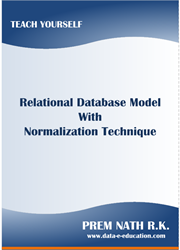

- Relational Algebra Operators
-
- Operators and Symbols
- Selection Operator
- Projection Operator
- Cartesian Product Operator
- Natural Join Operator
- Theta Join Operator
- Left Outer Join Operator
- Right Outer Join Operator
- Full Outer Join Operator
- Division Operator
- SET Union Operator
- SET Difference Operator
- SET Intersection Operator
- Rename Operator
Boyce-Codd Normal Form (BCNF)
Boyce Codd Normal Form is introduced by Raymond F. Boyce and E.F. Codd based on Functional Dependency. BCNF definition is "a table is in Boyce-Codd normal form if and only if for every one of its non-trivial functional dependencies X hold Y, X is a superkey that is, X is either a candidate key or a superset thereof."
BCNF is used to eliminate non-trivial dependencies between candidate key attributes from one entity that attributes moved into external entity to avoid update, insert and delete anomalies.
An instance, an Employee_Contact_Information entity is maintains data through Emp_Code, Emp_Name, Address, City_Name, Postal_Code and Contact_Number attributes. The Emp_Code, City_Name, Postal_Code are prime attributes in the table is in 3NF.
The combination of {Emp_Code, City_Name, Postal_Code} is superkey and {Emp_Code, City_Name} or {Emp_Code, Postal_Code} is candidate key of Employee_Contact_Information entity. The non-trivial functional dependency is {Emp_Code, City_Name} hold {Postal_Code} that {Postal_Code} hold {City_Name} attribute's data.
According to the BCNF, the City_Name attribute can move into external Postal_City entity to avoid redundant data. The decomposed Employee_Contact_Information entity can relate with Postal_City entity through common Postal_Code attribute and Referential Integrity Constraints.

Boyce Codd Normal Form is introduced by Raymond F. Boyce and E.F. Codd based on Functional Dependency. BCNF definition is "a table is in Boyce-Codd normal form if and only if for every one of its non-trivial functional dependencies X hold Y, X is a superkey that is, X is either a candidate key or a superset thereof."
BCNF is used to eliminate non-trivial dependencies between candidate key attributes from one entity that attributes moved into external entity to avoid update, insert and delete anomalies.
An instance, an Employee_Contact_Information entity is maintains data through Emp_Code, Emp_Name, Address, City_Name, Postal_Code and Contact_Number attributes. The Emp_Code, City_Name, Postal_Code are prime attributes in the table is in 3NF.
The combination of {Emp_Code, City_Name, Postal_Code} is superkey and {Emp_Code, City_Name} or {Emp_Code, Postal_Code} is candidate key of Employee_Contact_Information entity. The non-trivial functional dependency is {Emp_Code, City_Name} hold {Postal_Code} that {Postal_Code} hold {City_Name} attribute's data.
According to the BCNF, the City_Name attribute can move into external Postal_City entity to avoid redundant data. The decomposed Employee_Contact_Information entity can relate with Postal_City entity through common Postal_Code attribute and Referential Integrity Constraints.

|
|
Copyright © 2010 data-e-education.com. All rights reserved.
